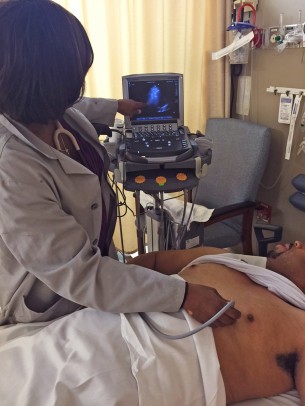Treating uncontrolled hypertension in the emergency room
Researchers at the University of Illinois at Chicago have received a $560,000, one-year grant from the National Institutes of Health to test the efficacy of an emergency-room intervention to treat uncontrolled high blood pressure.
High blood pressure, or hypertension, is one of the most common health conditions. Uncontrolled hypertension disproportionately affects minorities and can be associated with smoking, obesity and a sedentary lifestyle. In Chicago, the condition affects about 55 percent of African Americans and Latinos.
Known as “the silent killer,” hypertension may not produce any symptoms for a patient to notice. But left uncontrolled, it becomes a major risk factor for life-threatening diseases, which bring many patients to the hospital emergency room, says Dr. Heather Prendergast, professor of emergency medicine in the UIC College of Medicine and primary investigator on the grant.
“We see patients on a daily basis with kidney failure, heart disease, strokes and heart attacks,” Prendergast said. “What if we could reach patients sooner, before they develop these serious complications from hypertension? Then we could start to prevent serious disease and the need for costly treatment.”
Hospital emergency departments can address hypertension by educating patients with printed handouts and by recommending follow-up with their primary-care provider for blood-pressure treatment. But most patients “fall through the cracks,” Prendergast says.
“Because there are usually no symptoms related to high blood pressure at its earlier stages, the sense of urgency to follow up isn’t as strong as it should be for patients,” she said.
Prendergast believes that because hypertension is so prevalent also treatable, stronger interventions should be tested so that successful approaches can be incorporated into new national guidelines.
Under the new grant, she and her colleagues will enroll 120 patients from the University of Illinois Hospital’s emergency department found to have undiagnosed stage 2 hypertension and who don’t have a primary-care provider.
Patients will receive one of three interventions: One group receiving “usual care” will be given a phone number for the UI Health Mile Square Health Center and urged to call for a doctor’s appointment for their high blood pressure.
Another group will watch a three-minute video on hypertension and lifestyle changes that can help bring blood pressure down before they leave the emergency department. They will also get a heart ultrasound to look for early changes from uncontrolled hypertension, which tends to enlarge the heart, and a urine test to look for micro-albumin, an early indicator of kidney damage caused by high blood pressure. Follow-up visits will be scheduled for these patients at Mile Square Health Center.
“We want to do the albumin check because doing a cardiac ultrasound on every patient with hypertension may not be feasible in some emergency departments,” said Prendergast, who is focused on controlling high blood pressure in patients across the nation through the adoption of new guidelines. Urine tests are much simpler than cardiac ultrasounds. “If we can match albumin levels to what we see in hypertensive hearts,” she said, emergency departments will more easily be able to identify patients at highest risk of developing early complications. And early changes are often reversible by quitting smoking, eating a healthier diet, exercising, or taking medications if needed.
“Telling patients that their condition is within their power to address is very powerful,” she said.
A third group of patients will watch the video, receive the cardiac ultrasound, and have a follow-up appointment made for them, but also be enrolled in a hypertension transition program. These patients will be asked to return to the emergency department within three days of their initial visit for a re-check of their blood pressure and review of their results with a clinical pharmacist. The transition appointment will serve as a bridge between the first trip to the emergency room and the scheduled primary-care appointment.
All patients will receive a home blood-pressure monitor and be followed at six months and and a year for changes in blood pressure.
Prendergast expects patients in the third group to have the biggest improvement in blood pressure.
“Showing patients what their hypertensive heart looks like on an ultrasound was very motivating in our pilot study,” she said. “Empowering patients with the information they need to make changes and having them return to the emergency department for a transition-of-care follow-up visit makes getting treated much easier because they are familiar with the emergency department.
“Sometimes making an appointment or seeing a new physician can be a barrier to care.”

